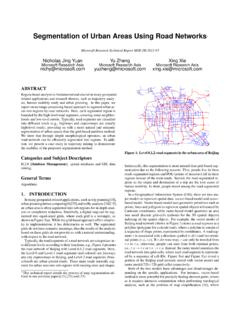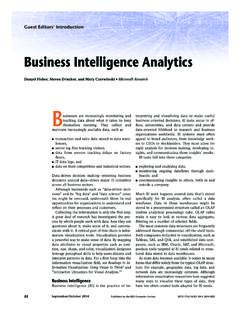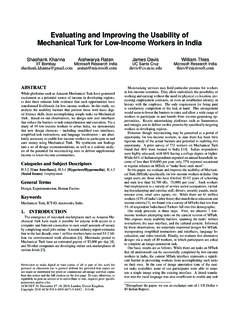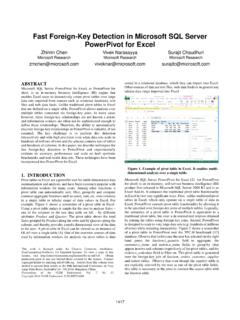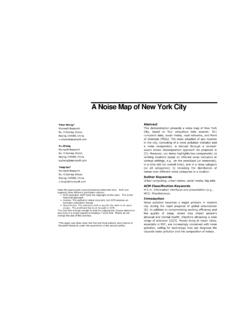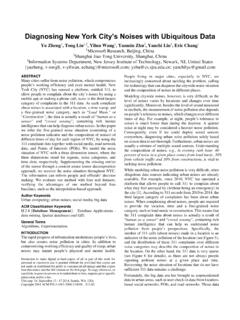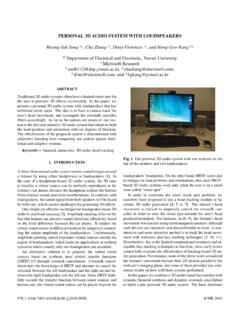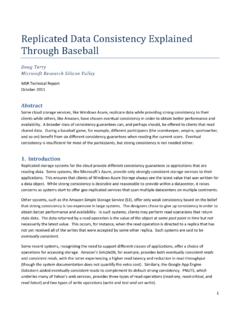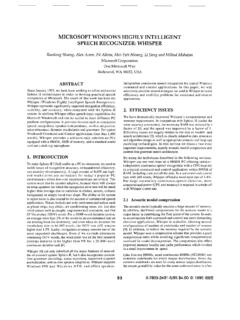Transcription of A Flexible New Technique for Camera Calibration
1 A Flexible New Technique for CameraCalibrationZhengyou ZhangDecember 2, 1998(updated on December 14, 1998)(updated on March 25, 1999)(updated on Aug. 10, 2002; a typo in Appendix B)(last updated on Aug. 13, 2008; a typo in Section )Technical ReportMSR-TR-98-71 Microsoft ResearchMicrosoft CorporationOne Microsoft WayRedmond, WA zhangA Flexible New Technique for Camera CalibrationZhengyou ZhangMicrosoft Research, One Microsoft Way, Redmond, WA 98052-6399, zhangContents1 Motivations22 Basic .. between the model plane and its image .. on the intrinsic parameters .. Interpretation ..43 Solving Camera solution .. likelihood estimation .. with radial distortion ..84 Degenerate Configurations85 Experimental Simulations .. Data .. with Respect to Model Imprecision.
2 Noise in the model points .. non-planarity of the model pattern ..156 Conclusion17A Estimation of the homography Between the Model Plane and its Image17B Extraction of the Intrinsic Parameters from MatrixB18C Approximating a3 3matrix by a Rotation Matrix18D Camera Calibration Under Known Pure Translation 19 added on December 14, 1998 added on December 28, 1998; added results on systematic non-planarity on March 25, 1998 added on December 14, 1998, corrected (based on the comments from Andrew Zisserman) on January 7, 19991A Flexible New Technique for Camera CalibrationAbstractWe propose a Flexible new Technique to easily calibrate a Camera . It is well suited for usewithout specialized knowledge of 3D geometry or computer vision. The Technique only requiresthe Camera to observe a planar pattern shown at a few (at least two) different orientations.
3 Eitherthe Camera or the planar pattern can be freely moved. The motion need not be known. Radial lensdistortion is modeled. The proposed procedure consists of a closed-form solution, followed by anonlinear refinement based on the maximum likelihood criterion. Both computer simulation andreal data have been used to test the proposed Technique , and very good results have been with classical techniques which use expensive equipment such as two or three orthog-onal planes, the proposed Technique is easy to use and Flexible . It advances 3D computer visionone step from laboratory environments to real world Terms Camera Calibration , Calibration from planes, 2D pattern, absolute conic, projectivemapping, lens distortion, closed-form solution, maximum likelihood estimation, Flexible MotivationsCamera Calibration is a necessary step in 3D computer vision in order to extract metric informationfrom 2D images.
4 Much work has been done, starting in the photogrammetry community (see [2,4] to cite a few), and more recently in computer vision ([9, 8, 23, 7, 26, 24, 17, 6] to cite a few).We can classify those techniques roughly into two categories: photogrammetric Calibration and Calibration is performed by observing a Calibration objectwhose geometry in 3-D space is known with very good precision. Calibration can be done veryefficiently [5]. The Calibration object usually consists of two or three planes orthogonal to eachother. Sometimes, a plane undergoing a precisely known translation is also used [23]. Theseapproaches require an expensive Calibration apparatus, and an elaborate in this category do not use any Calibration object. Just by moving acamera in a static scene, the rigidity of the scene provides in general two constraints [17, 15]on the cameras internal parameters from one Camera displacement by using image informa-tion alone.
5 Therefore, if images are taken by the same Camera with fixed internal parameters,correspondences between three images are sufficient to recover both the internal and externalparameters which allow us to reconstruct 3-D structure up to a similarity [16, 13]. While this ap-proach is very Flexible , it is not yet mature [1]. Because there are many parameters to estimate,we cannot always obtain reliable techniques exist: vanishing points for orthogonal directions [3, 14], and Calibration from purerotation [11, 21].Our current research is focused on a desktop vision system (DVS) since the potential for usingDVSs is large. Cameras are becoming cheap and ubiquitous. A DVS aims at the general public,who are not experts in computer vision. A typical computer user will perform vision tasks only fromtime to time, so will not be willing to invest money for expensive equipment.
6 Therefore, flexibility,robustness and low cost are important. The Camera Calibration Technique described in this paper wasdeveloped with these considerations in proposed Technique only requires the Camera to observe a planar pattern shown at a few (atleast two) different orientations. The pattern can be printed on a laser printer and attached to a rea-sonable planar surface ( , a hard book cover). Either the Camera or the planar pattern can be movedby hand. The motion need not be known. The proposed approach lies between the photogrammet-ric Calibration and self- Calibration , because we use 2D metric information rather than 3D or purelyimplicit one. Both computer simulation and real data have been used to test the proposed Technique ,and very good results have been obtained. Compared with classical techniques, the proposed tech-nique is considerably more Flexible .
7 Compared with self- Calibration , it gains considerable degree ofrobustness. We believe the new Technique advances 3D computer vision one step from laboratoryenvironments to the real that Bill Triggs [22] recently developed a self- Calibration Technique from at least 5 views ofa planar scene. His Technique is more Flexible than ours, but has difficulty to initialize. Liebowitz andZisserman [14] described a Technique of metric rectification for perspective images of planes usingmetric information such as a known angle, two equal though unknown angles, and a known lengthratio. They also mentioned that Calibration of the internal Camera parameters is possible provided atleast three such rectified planes, although no experimental results were paper is organized as follows. Section 2 describes the basic constraints from observing asingle plane.
8 Section 3 describes the Calibration procedure. We start with a closed-form solution,followed by nonlinear optimization. Radial lens distortion is also modeled. Section 4 studies con-figurations in which the proposed Calibration Technique fails. It is very easy to avoid such situationsin practice. Section 5 provides the experimental results. Both computer simulation and real data areused to validate the proposed Technique . In the Appendix, we provides a number of details, includingthe techniques for estimating the homography between the model plane and its Basic EquationsWe examine the constraints on the Camera s intrinsic parameters provided by observing a single start with the notation used in this NotationA 2D point is denoted bym= [u, v]T. A 3D point is denoted byM= [X, Y, Z]T. We use xto denotethe augmented vector by adding 1 as the last element: m= [u, v,1]Tand M= [X, Y, Z,1]T.
9 A camerais modeled by the usual pinhole: the relationship between a 3D pointMand its image projectionmisgiven bys m=A[R t] M,(1)wheresis an arbitrary scale factor,(R,t), called the extrinsic parameters, is the rotation and trans-lation which relates the world coordinate system to the Camera coordinate system, andA, called thecamera intrinsic matrix, is given byA= u00 v00 0 1 with(u0, v0)the coordinates of the principal point, and the scale factors in imageuandvaxes,and the parameter describing the skewness of the two image use the abbreviationA Tfor(A 1)Tor(AT) homography between the model plane and its imageWithout loss of generality, we assume the model plane is onZ= 0of the world coordinate s denote theithcolumn of the rotation matrixRbyri. From (1), we haves uv1 =A[r1r2r3t] XY01 =A[r1r2t] XY1.
10 By abuse of notation, we still useMto denote a point on the model plane, butM= [X, Y]TsinceZisalways equal to 0. In turn, M= [X, Y,1]T. Therefore, a model pointMand its imagemis related by ahomographyH:s m=H MwithH=A[r1r2t].(2)As is clear, the3 3matrixHis defined up to a scale Constraints on the intrinsic parametersGiven an image of the model plane, an homography can be estimated (see Appendix A). Let s denoteit byH=[h1h2h3]. From (2), we have[h1h2h3]= A[r1r2t],where is an arbitrary scalar. Using the knowledge thatr1andr2are orthonormal, we havehT1A TA 1h2= 0(3)hT1A TA 1h1=hT2A TA 1h2.(4)These are the two basic constraints on the intrinsic parameters, given one homography . Because ahomography has 8 degrees of freedom and there are 6 extrinsic parameters (3 for rotation and 3 fortranslation), we can only obtain 2 constraints on the intrinsic parameters.
